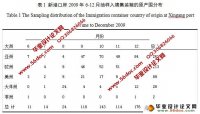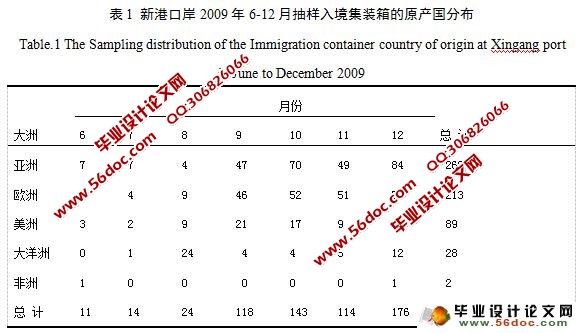长沙新港入境集装箱有害生物风险分析
来源:wenku7.com 资料编号:WK711193 资料等级:★★★★★ %E8%B5%84%E6%96%99%E7%BC%96%E5%8F%B7%EF%BC%9AWK711193

资料介绍
长沙新港入境集装箱有害生物风险分析(毕业论文6220字) 摘 要:为了加强对入境集装箱的针对性建议检查,提高监管力度,控制有害生物因子通过入境集装箱传入。随机抽取长沙新港口岸2009年6-12月的入境集装箱有害生物风险分析备案单,并对备案情况进行统计分析。结果表明,长沙新港入境集装箱携带病媒等有害生物因子的检出率在6-9月明显高于10-12月,呈现季节性变化。检出有害生物因子种类繁多,但是主要以病媒生物为主。检出有害生物集装箱的输入国主要集中在美国、德国和日本。提出了根据输入国、境集装箱数量、入境季节有针对性地增强检疫查验力度和卫生除害处理力度的风险管理对策。 关键词:有害生物;PRA;风险分析;入境集装箱;除害处理; Pest Risk Analysis of Entry Container in Changsha Xingang port Abstract: In order to enhance the relevance of inbound containers is recommended to check and improve the supervision and control of harmful biological factors containers passing through immigration. Xingang Port of Changsha randomly selected from June to December 2009 the entry container pest risk analysis for the record alone, and for the record was statistically analyzed. The results show that the vector carrying the container entry Changsha Port of harmful biological factors such as the detection rate in June to September was significantly higher than in October to December, showing seasonal changes. There is the wide range of detection of harmful biological factors, while mainly in vector organisms. The Detection of harmful biological container importing countries is mainly in the United States, Germany and Japan. Proposed based on the importing country, the number of containers throughout the entry targeted to enhance the seasonal dynamics and health inspection and quarantine pest elimination efforts in the risk management measures. Key words: Pest; PRA; Risk analysis; Entry container;insecticide treatment; 目 录
摘要……………………………………………………………………………………1
关键词…………………………………………………………………………………1
1 前言…………………………………………………………………………………2
2 材料和方法…………………………………………………………………………2
2.1材料………………………………………………………………………………2
2.2 方法 ……………………………………………………………………………2
3 结果…………………………………………………………………………………3
3.1 入境地区………………………………………………………………………3
3.2 装载货物种类…………………………………………………………………3
3.3病媒因子……………………………………………………………………3
3.4 除害处理………………………………………………………………………5
3.5 结果比对………………………………………………………………………6
4 讨论…………………………………………………………………………………6
5 结论……………………………………………………………………………7
参考文献………………………………………………………………………………7
致谢……………………………………………………………………………………9
目 录
摘要……………………………………………………………………………………1
关键词…………………………………………………………………………………1
1 前言…………………………………………………………………………………2
2 材料和方法…………………………………………………………………………2
2.1材料………………………………………………………………………………2
2.2 方法 ……………………………………………………………………………2
3 结果…………………………………………………………………………………3
3.1 入境地区………………………………………………………………………3
3.2 装载货物种类…………………………………………………………………3
3.3病媒因子……………………………………………………………………3
3.4 除害处理………………………………………………………………………5
3.5 结果比对………………………………………………………………………6
4 讨论…………………………………………………………………………………6
5 结论……………………………………………………………………………7
参考文献………………………………………………………………………………7
致谢……………………………………………………………………………………9 |